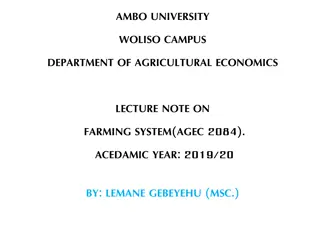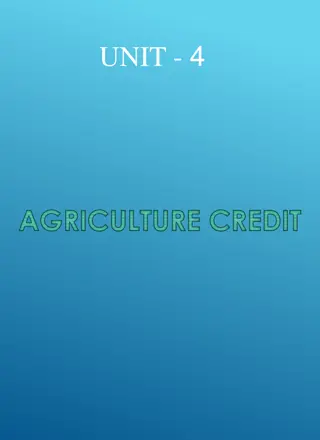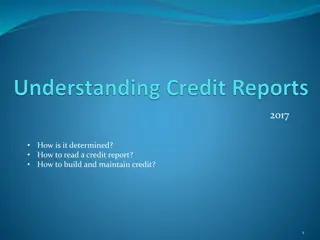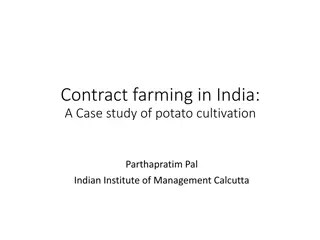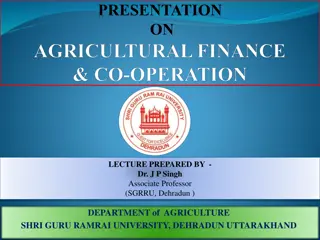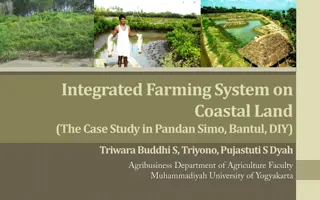Understanding Agricultural Credit and Its Importance in Farming
Agricultural credit plays a crucial role in supporting farmers by providing financial assistance for various needs such as purchasing inputs, implements, managing risks, improving land, enhancing product marketing, and facing crises. Different types of agricultural credit include short-term and medium-term credit, each serving specific purposes in agricultural operations.
Download Presentation

Please find below an Image/Link to download the presentation.
The content on the website is provided AS IS for your information and personal use only. It may not be sold, licensed, or shared on other websites without obtaining consent from the author. Download presentation by click this link. If you encounter any issues during the download, it is possible that the publisher has removed the file from their server.
E N D
Presentation Transcript
Agricultural Credit and its Need Types of Agricultural Credit and its Sources Problems of Rural Credit Remedial Measure
Agricultural Credit: The credit needed by farmers to grow the agricultural sector is termed asAgricultural Credit. Credit is required in every type of business and agriculture is not exception to it. The need for agricultural credit, however, becomes all the more important when it moves from traditional agriculture to modern agriculture
Need forAgricultural Credit: 1. Purchase of new inputs The farmers need finance for the purchase of new inputs which include seeds, fertilizers, pesticides etc. 2. Purchase of Implements: Credit is required by the farmers for the purchase water pumping sets, tractors, threshers etc. the use of appropriate machinery in land will increase production by growing more than one crop on the same piece of land at the same time 3. Better Management of Risk: Credit enables the farmers to better to manage the risk of uncertainties of price. they can borrow money during bad years and pay back the loans during good years of crops.
4. Permanent Improvement in Land: Credit also helps the farmers to make permanent improvements in land like sinking of wells, land reclamation, etc 5. Better marketing of Products: if timely credit is available to the farmers, they will not sell the produce immediately after the harvest is over. At that time the prices of agricultural goods are low in the market. Credit enables the farmers to withhold the agricultural surplus and sell it in the market when prices are high. 6. To Face Crisis: The credit is required by the farmers to face crisis. The crisis can be caused by the failure of crop, draught or floods etc.
Types ofAgricultural Credit: 1.Short-term Credit: The short-term credit ranges up to one year. The farmers need short-term credit for meeting the working capital requirements of agriculture. For instance, they need short-term credit for the purchase of seeds, fertilizers, pesticides, bullocks and other casual expenses. The short-term credit is repaid after marketing the produce of the next crop 2.Medium-Term Credit: Medium-term Credit extends from 1 to 5 years. The farmers require medium-term credit for the purchase of cattle, purchase of implements, improvement in water course. The loan is obtained on the security of movable or immovable wealth of the farmers
3 Long-Term Credit: The duration of long-term credit exceeds 5 years. The farmers need long-term credit for making improvement of permanent nature in land such as sinking of tube wells, purchase of machinery and implements etc
Factors contributing to the growth of agricultural credit 1. Growth of rural branches of commercial banks 2. Establishment of Regional Rural Banks (RRBs) 3. Priority Sector Lending 4. Rate of Interest for Shortfall in Agriculture Lending 5. Self-Help Groups (SHG)-Bank linkage Programme 6. Special Agriculture Credit Plan 7. . Kisan Credit Cards 9. Financial Inclusion Programmes
CreditAssessment : Lending institutions want to lend money because it s the way they make money. However, they only want to lend money to a borrower who is able to repay the loan on time and in full. The credit analysis process refers to evaluating a borrower s loan application to determine the financial health of an entity and its ability to generate sufficient cash flows to service the debt. In simple terms, a lender conducts credit analysis on potential borrowers to determine their creditworthiness and the level of credit risk associated with extending credit to them.
Lenders customarily analyze the credit worthiness of the borrower by using the Five C s: capacity, capital, collateral, conditions, character. Each of these criteria helps the lender to determine the overall risk of the loan. While each of the C s is evaluated, none of them on their own will prevent or ensure access to financing. They are only a variety of factors that lenders evaluate to determine how much of a risk the potential borrower is for the financial institution.
Three Rs of Credits 1.Returns 2.Repayment capacity 3.Risk bearing ability
7PS The modern rural financing institutions have to follow principles of farm finance not only to achieve commercial gains but also to bring about social benefits. By the combination of principles of economics, banking and farm management along with the existing principles, the following principles of farm finance have been evolved, on the basis of the definition adopted for the concept of farm finance for development
7Ps Principle of Productive Purpose, Principle of Personality, Principle of Productivity, Principle of Phased disbursement, Principle of Proper utilization, Principle of repayment, and Principle of protection




